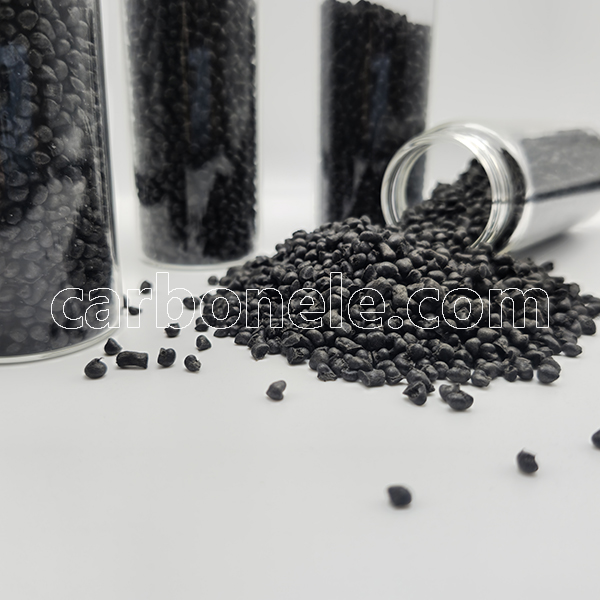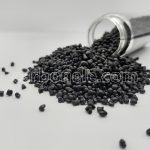
PPA CF30 30% Carbon Fiber PPA Compounds
PPA CF30 is chosen for applications where a balance of high strength, lightweight construction, chemical resistance, and thermal stability is required. Its properties make it suitable for demanding industries such as automotive, aerospace, electronics, and industrial manufacturing.
- Model: PPA-CF-BCA3
- Formula: Carbon fiber
- Manufacturer: Yes
- OEM: Acceptable
- Free sample: Available
- Origin country: China
What’s PPA CF30?
“PPA CF30” typically refers to a composite material that combines Polyphthalamide (PPA) resin with 30% Carbon Fiber (CF). Here’s a breakdown of each component:
1. **Polyphthalamide (PPA)**: PPA is a type of high-performance thermoplastic resin known for its excellent mechanical properties, including high strength, stiffness, and resistance to heat and chemicals. It is often used in applications where these properties are crucial, such as automotive, electrical, and industrial components.
2. **Carbon Fiber (CF)**: Carbon fiber is a strong and lightweight material made from carbon atoms bonded together in a crystalline structure. It exhibits high tensile strength, stiffness, and resistance to temperature and corrosion. In composite materials, carbon fiber is used to reinforce polymers like PPA, enhancing their mechanical properties.
3. **30%**: This percentage indicates the weight fraction of carbon fiber in the composite material. In PPA CF30, 30% of the material, by weight, consists of carbon fiber. This specific composition is chosen to achieve a balance of strength, stiffness, and other performance characteristics suitable for various demanding applications.
Key features & benefits:
1. **High Strength**: The inclusion of carbon fiber reinforcement significantly enhances the strength of the PPA resin. Carbon fiber is known for its high tensile strength, which translates to improved mechanical properties such as higher stiffness and resistance to deformation under load.
2. **Lightweight**: Despite its enhanced strength, PPA CF30 remains lightweight due to the low density of carbon fiber compared to metals. This characteristic makes it suitable for applications where weight reduction is critical, such as in automotive and aerospace industries.
3. **Stiffness**: Carbon fiber reinforcement contributes to increased stiffness in the composite material. This stiffness helps maintain dimensional stability and resistance to bending or flexing, enhancing the structural integrity of components made from PPA CF30.
4. **Chemical Resistance**: PPA resin itself offers excellent resistance to various chemicals, including automotive fluids and many industrial chemicals. When combined with carbon fiber, PPA CF30 retains these chemical-resistant properties, making it suitable for applications exposed to harsh environments.
5. **Thermal Stability**: Both PPA resin and carbon fiber exhibit good thermal stability. PPA can withstand high temperatures without significant degradation, while carbon fiber enhances heat resistance and thermal insulation properties of the composite.
6. **Design Flexibility**: PPA CF30 can be molded into complex shapes and designs using injection molding or other molding processes. This flexibility in manufacturing allows for the production of customized parts tailored to specific application requirements.
7. **Electrical Insulation**: PPA resin is inherently electrically insulating, making PPA CF30 suitable for applications requiring electrical insulation properties. This is important in electronics and electrical components where conductivity needs to be minimized.
8. **Dimensional Stability**: The combination of PPA resin and carbon fiber reinforcement results in low thermal expansion and excellent dimensional stability over a wide range of temperatures, ensuring consistent performance in varying environmental conditions.
Applications of PPA CF30:
PPA CF30 composites find applications in industries such as automotive (for structural components, under-the-hood parts), aerospace (for lightweight structures), electronics (for housings and connectors), and sporting goods (for high-performance equipment). The combination of PPA resin with carbon fiber reinforcement provides a lightweight yet strong material that can withstand mechanical stress and environmental conditions.
Content Block 1
Morbi iaculis at quam vel faucibus. Ut semper ipsum ex, quis aliquet justo pretium a. Suspendisse scelerisque metus augue, a interdum leo iaculis sed. Vivamus sit amet nunc odio. Duis vel pulvinar dolor, at lacinia tellus.
Pellentesque habitant morbi tristique senectus et netus et malesuada fames ac turpis egestas. Suspendisse lacinia quam a elit lobortis tempor


Content Block 1
Morbi iaculis at quam vel faucibus. Ut semper ipsum ex, quis aliquet justo pretium a. Suspendisse scelerisque metus augue, a interdum leo iaculis sed. Vivamus sit amet nunc odio. Duis vel pulvinar dolor, at lacinia tellus.
Pellentesque habitant morbi tristique senectus et netus et malesuada fames ac turpis egestas. Suspendisse lacinia quam a elit lobortis tempor

Frequently Asked Questions
Carbon (Xiamen) New Material Co., Ltd. aims to provide buyers with "one-stop" worry-free high-quality services. Here you can find all information about carbon fiber engineering plastics. If you still have questions, please send us an email for consultation!
-
How can I contact the manufacturer of a product that interests me?
When you find a product you are interested in, you can contact the manufacturer directly by sending an email and we will get back to you as soon as possible.
-
How do I find the products that interest me?
All you need to do is enter the keyword, product name in the search window and press the Enter key on your keyboard. Your search results page will then be displayed. You can also search within the product category pages on the home page. Each category is divided into subcategories, allowing you to refine your search and find products that interest you.
-
Where will I find a buying guide?
Please contact our after-sales service directly and we will provide you with a comprehensive operating guide.
-
What are CF Reinforced Thermoplastic Composites?
CF Reinforced Thermoplastic Composites are materials where carbon fibers are incorporated into a thermoplastic matrix. They combine the strength and stiffness of carbon fibers with the processability and recyclability of thermoplastics. For instance, they are used in automotive parts like bumper beams.
-
What are the benefits of CF Reinforced Thermoplastic Composites over traditional composites?
The key benefits include faster production cycles, easier recyclability, and better impact resistance. They also offer design flexibility. An example is in the manufacturing of consumer electronics casings where complex shapes can be achieved more easily.
-
How are CF Reinforced Thermoplastic Composites processed?
Common processing methods include injection molding, extrusion, and compression molding. Injection molding is widely used for mass production. For example, in the production of small components for the medical industry.
-
What industries use CF Reinforced Thermoplastic Composites?
They are utilized in aerospace, automotive, medical, and sports equipment industries. In aerospace, they can be found in interior components. In the medical field, they might be used in prosthetics.
-
How does the carbon fiber content affect the properties of the composites?
Higher carbon fiber content generally leads to increased strength and stiffness but may reduce ductility. A moderate content is often balanced for specific applications. For example, a higher content might be preferred in structural parts of a race car.
-
What are the challenges in using CF Reinforced Thermoplastic Composites?
Challenges include higher material costs, complex processing equipment requirements, and ensuring uniform fiber dispersion. Issues with adhesion between the fibers and the matrix can also arise. An example is in achieving consistent quality in large-scale production.

























